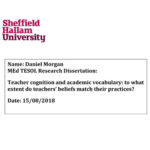English Language Teaching in India: The Shifting Paradigms
S. P. Dhanavel:, 2012. P 137, Price: Rs.199.
Reviewed by S. Kumaran, India
Tata McGraw Hill Education Pvt. Ltd., New Delhi
English Language Teaching in India: The Shifting Paradigms by S. P. Dhanavel, Professor, Department of English, Anna University, Chennai, is a collection of research papers, written over two decades. Its objective is to record the developments in ELT in India from a practicing teacher’s viewpoint. It traces the trajectory of English from literature-based teaching to soft skills teaching.
The book, which consists of 19 chapters on various topics like language skills, grammar, vocabulary, the link between ELT and soft skills, English for Science and Technology, and literature, examines the current status of English in India with an insight into the colonial legacy and the postcolonial double bind. It highlights the everyday problems in the Indian classroom and offers useful solutions for practitioners of ELT in India and abroad, specially neighboring countries.
One of the major reasons for the failure of ELT in India is its lack of direction for the learners. The first chapter addresses the development of English as a world language and prepares the readers, primarily teachers at the tertiary level, for empowering English learners. The second chapter is an appeal to the policy makers and administrators to formulate a consistently strong language policy so that the efforts of teachers of English would give the desired results. Chapters three and four describe the impact of globalization and information technology on English and urges teachers of English to adopt Computer-Assisted Language Learning (CALL) judiciously in order to be more competitive in the global market. The best solution, in the author’s view, for mastering English is by tapping into the intrinsic motivation of both learners and teachers, which is addressed in Chapter 6.
An innovative aspect of this book is a record of the experiments the author conducted at Anna University, Chennai. It shows that any teacher can conduct similar activities anywhere to ensure the successful learning of English. While discussing technology-enabled language learning in Chapter 4, Dhanavel reveals how Anna University students were encouraged to explore various forms of technology, especially blog writing as a part of learning English. In Chapter 5, the author investigates content related to engineering and technology in teaching English to first year undergraduate engineering students. He analyses how a simple question from a student regarding the word ‘crux’ enabled him to discover the potential of technical content simulating present real-life situations in the classroom. In Chapter 13, he proposes a new approach tried with first year engineering students at Anna University. The students were predominantly from Tamil medium background. The interesting finding of the research is that students learned to write sentences and discovered new meanings at the same time.
Historically, the Key English Language Teaching (KELT) project undertaken by the Department of English of the university in 1988 and its outcome in the syllabus of Technical English I and II, which relies on English for Specific Purposes (ESP), is important for teachers of English in India and elsewhere. He questions the experimental results and suggests a way forward for multipurpose English teaching programs in Chapter 18.
The strength of the book lies in chapters 7, 8, and 13. The 5S approach to vocabulary teaching in chapter 7 is quite interesting as it involves Sight, Sound, Source, Sense, and Syntax of a word in question. Generally, grammar and composition are considered difficult by students and dull by teachers but the author perceives them exciting in Chapter 8 and offers new techniques through a number of acronyms to teach them. For example, VANPAPCI stands for the eight parts of speech and DEAN stands for four modes of discourse: Description, Exposition, Argumentation, and Narration. The integrated approach to teaching writing proposed in Chapter 13 discusses three levels of writing. Thus, through these thought-provoking and practical techniques, the author has opened new grounds for English teaching.
A current trend in ELT is the teaching of soft skills, also called people skills, which are needed for one’s professional success. Dhanavel discusses them in Chapter 14 and has a separate textbook on English and Soft Skills (2010). Undoubtedly, the author’s focus on thinking as an integral part of communication skills in Chapter 15 will urge teachers to relate thinking with all four language skills. Further, he has included non-verbal communication skills in Chapter 16. His use of proverbs in teaching and learning English and soft skills in Chapter 17 draws sustenance from the wisdom of the ages for successful learning and teaching.
Though the book has achieved its objectives of documenting the shifting paradigms of ELT in India and suggesting innovative techniques for teaching and learning English, it is specific to the experience of an English teacher from a technical university in Tamilnadu. The attempt to explain the pronunciation of the letter ‘x’ in Chapter 10 seems inadequate. Knowing the pronunciation of “x” alone may not help everybody to speak English well. However, English Language Teaching in India: The Shifting Paradigms will remain a perennial source of inspiration and innovation not only for teachers of English in India but also for teachers in other countries.








